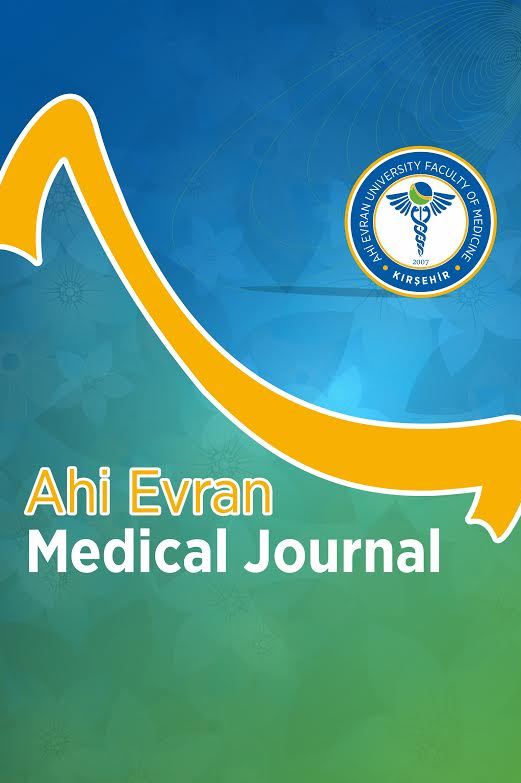İntertrokanterik Femur Kırıkları Tedavisinde Hemiartroplastide Yaklaşım Seçimi: Anterolateral ya da Posterolateral?
hemiartroplasti, intertrokanterik femur kırığı, anterolateral, posterolateral, yaklaşım
Choice of Approach in Hemiarthroplasty For Intertrochanteric Femur Fractures: Anterolateral or Posterolateral?
hemiarthroplasty, intertrochanteric femur fracture, anterolateral, posterolateral, approach,
___
- 1. Hardinge K, Cleary J, Charnley J. Low-friction arthroplasty for healed septic and tuberculous arthritis. J Bone Joint Surg Br. 1979;61(2):144-147.
- 2. Palan J, Beard DJ, Murray DW, Andrew JG, Nolan J. Which approach for total hip arthroplasty: Anterolateral or posterior? Clin Orthop Relat Res. 2009;467(2):473-477.
- 3. Gibson A. Posterior exposure of the hip joint. J Bone Joint Surg Br. 1950;32(2):183-186.
- 4. Klasan A, Neri T, Oberkircher L, Malcherczyk D, Heyse TJ, Bliemel C. Complications after direct anterior versus Watson-Jones approach in total hip arthroplasty: results from a matched pair analysis on 1408 patients. BMC Musculoskelet Disord. 2019;20(77):1-7.
- 5. Weber M, Hempfing A, Orler R, Ganz R. Femoral revision using the wagner stem: Results at 2-9 years. Int Orthop. 2002;26(1):36-39.
- 6. Bauer R, Kerschbaumer F, Poisel S, Oberthaler W. The transgluteal approach to the hip joint. Arch Orthop Trauma Surg. 1979;95(1-2):47-49.
- 7. Harris WH. A new lateral approach to the hip joint. J Bone Joint Surg Am. 1967;49(5):891-898.
- 8. Muller ME. Total hip prostheses. Clin Orthop Relat Res. 1970;72:46-68.
- 9. Mehlman CT, Meiss L, DiPasquale TG. Hyphenated-history: The kocher-langenbeck surgical approach. J Orthop Trauma. 2000;14(1):60-64.
- 10. Roberts JM, Fu FH, McClain EJ, Ferguson AB, Jr. A comparison of the posterolateral and anterolateral approaches to total hip arthroplasty. Clin Orthop Relat Res. 1984;187:205-210.
- 11. Yue C, Kang P, Pei F. Comparison of direct anterior and lateral approaches in total hip arthroplasty: A systematic review and meta-analysis (prisma). Medicine (Baltimore). 2015;94(50):e2126.
- 12. Meinberg EG, Agel J, Roberts CS, Karam MD, Kellam JF. Fracture and dislocation classification compendium-2018. J Orthop Trauma. 2018;32(1):1-170.
- 13. Harris WH. Traumatic arthritis of the hip after dislocation and acetabular fractures: Treatment by mold arthroplasty. An end-result study using a new method of result evaluation. J Bone Joint Surg Am. 1969;51(4):737-755.
- 14. Ham OK, Kang Y, Teng H, Lee Y, Im EO. Consistency and accuracy of multiple pain scales measured in cancer patients from multiple ethnic groups. Cancer Nurs. 2015;38(4):305-311.
- 15. Hardinge K. The direct lateral approach to the hip. J Bone Joint Surg Br. 1982;64(1):17-19.
- 16. Restrepo C, Parvizi J, Pour AE, Hozack WJ. Prospective randomized study of two surgical approaches for total hip arthroplasty. J Arthroplasty. 2010;25(5):671-679.
- 17. Bhise S BS, Desai S, Kanode N. Comparative study of patients who underwent hemiarthroplasty of hip by anterolateral and posterolateral approach. Int J Sci Stud. 2018;6(2):36-38.
- 18. Kiyama T, Naito M, Shinoda T, Maeyama A. Hip abductor strengths after total hip arthroplasty via the lateral and posterolateral approaches. J Arthroplasty. 2010;25(1):76-80.
- 19. Hasija R, Kelly JJ, Shah NV, et al. Nerve injuries associated with total hip arthroplasty. J Clin Orthop Trauma. 2018;9(1):81-86.
- 20. Khan T, Knowles D. Damage to the superior gluteal nerve during the direct lateral approach to the hip: A cadaveric study. J Arthroplasty. 2007;22(8):1198-1200.
- 21. Wroblewski A, Hoffman D, Miller ET. Direct anterior approach for hip hemiarthroplasty. J Orthop Trauma. 2019;33(1):17-18.
- Yayın Aralığı: Yılda 3 Sayı
- Başlangıç: 2017
- Yayıncı: Kırşehir Ahi Evran Üniversitesi
Hemolitik Üremik Sendrom; 10 Yıllık Tek Merkez Deneyimi
Ayşe Seda PINARBAŞI, Sibel YEL, Neslihan GÜNAY, Hakan POYRAZOĞLU, Aynur GENCER BALABAN, İsmail DURSUN, Zübeyde GÜNDÜZ, Ruhan DÜŞÜNSEL
Tiroid Hormon İlişkili Deiyodinaz Enzim Seviyelerindeki Değişikliklere Selenyumun Etkisi
Ercan BABUR, Umut BAKKALOĞLU, Cem SÜER, Nurcan DURSUN
Emrah ÖZCAN, Sefa Haktan HATIK, Demet TEKİN
Tarsal Tünelde Anormal Bir İlişki: Olgu Sunumu
Yaygın Evre Küçük Hücreli Akciğer Kanserinde Lenfosit/Monosit Oranının Prognostik Önemi
Yakup İRİAĞAÇ, Eyyüp ÇAVDAR, Ahmet YOLCU
Uyku Polikliniğine Başvuran Hastaların Bir Yıllık Verilerinin Genel Analizi
Mehmet YETİŞ, Gökay EKEN, Mustafa ÖZÇAMDALLI
Nur DOKUZEYLÜL GÜNGÖR, Tuğba GÜRBÜZ, Arzu YURCİ
Osman BÜYÜKŞEN, Süleyman BAYRAKTAR, Murat ELEVLİ
